The following is part one of a multi-part series of posts on the subject of hand bolting, based on my book Higher Education, with later parts covering how to drill and the best equipment to use. I will take questions at the bottom from paid subscribers.
The knowledge of how and why bolts and rivets are employed on a big wall is of vital importance, whether you’re making a first ascent or the hundredth ascent. All teams will attempt to keep the number of bolts and rivets to an absolute minimum - the hole count - knowing that to over drill will both reduce the difficulty of their route as well as undermine how others view their skill as climbers. The knowledge of how to drill bolts and rivets is not only vital for first ascensionists, but also for big wall emergency and self-rescue, as bolts and rivets may need replacing, or new ones may need to be placed, to bridge the gap between missing features and blank sections.
WHY NOT GO FOR NATURAL BELAYS?
The natural belay is always the most preferred belay as it’s fast to build and take down and does not require invasive drilling. The problem with natural belays is that very often they require key pieces of equipment that may be needed on the next pitch, or may have been used already on reaching the belay. The Nose, for example, could feature all-natural belays using just wires and cams, but this would mean a doubling up of gear and extra weight.
Another factor is that by bolting belays you aid a retreat, vital on very steep lines as well as popular ones. If The Nose was cleaned of belay bolts then retreat would probably be impossible from high on the wall, a whole rack needed to safely get everyone and everything down in one piece.
There is also the problem that very often natural features do not make ideal belay positions, that creating a belay in a vertical crack bunches up everything and everyone, where two bolts set a metre apart does not. There is also the safety factor of drilling into solid rock rather than trusting flakes, cracks and features that can - and have - proved to be unsound. The deaths of Finn Daehli and Hans Christian Doseth in 1984 on Great Trango has been put down to catastrophic belay failure while descending, a crushed cam, evidence that the rock may have moved or broken away.
There is also something in the neatness and construction of a route, to make very long technical pitches that lead to perfect belays that are ideal for camps and hauling, the bolts part of the artistry of the leader.
ETHICS
Climbing big walls is primarily about searching out the impossible, using as little as you can to ascend the hardest, blankest walls you can find. The second you get out your drill you are admitting some kind of moral defeat, and so drill- ing is viewed as one of the most serious actions on a wall, so consider the following points:
Murder Of The Impossible: Messner’s rage against the ‘murder of the impossible’ was a rage against the bolted direttissima, where hundreds of bolts were placed, by both hand and machine, in order to scale the blankest walls, turn- ing a high skill game into DIY. Routes like the now de-bolted compressor route on Cerro Torre were great examples of man’s arrogance and hubris, but such climbs have also served as an example to excess, a valuable message that success at all costs, costs too much, costs your reputation, costs the route you create, and costs the mountain, its walls littered with piercings.
Should We Drill?: So the first question we need to ask is; is this necessary? Well, the answer on many big walls is yes. Due to the huge loads involved, the black nature of the rock, the lack of gear to create highly complex natural belays when they can be found means that bolted belays are pretty much a necessity. As for lead bolts or rivets, if you’re creating a route that’s a work of art then sometimes it is necessary to link small features together when climbing new routes, or drill blank sections when a feature is ripped off the wall. On most new routes a hole count is kept and this is set beside the climb to determine if massive bolting was justifiable, as with enough drill, bolts and battery power anything can be climbed.
Big Wall Junk: The world of bolting and drilling is a very complex one, big wall bolting even more so, with a long, complicated, and often murky past, leaving behind tons of crappy and dangerous bolts and hangers. In the past climbers used what bolts they could find, or make, as well as homemade hangers sawn from bits of steel, iron or alloy. These time bombs were often deadly even when they were placed, and although ancient, even now you can come across junk protection like this on popular walls. Some people feel that crap gear is part of the game, that when you come across a machine head rivet and you don’t know if it goes in 30 threads deep or only 5 then that’s OK, it gives the pitch spice. But the first ascensionist knew, they placed the junk, so it’s creating false jeopardy, like planting a field full of mines then asking someone else to walk across it. The same goes for a whole pitch of bat hooks, again scary, but not so much when you’re drilling them, know where they are, know how deep they go.
If You Drill It Fill It And Fill It Good: And so instead of this cheapskate approach of the past, climbers are now taking the issue of bolting routes more seriously, using high end, high strength and long-lasting hardware that will last decades, if not centuries. The idea of placing shoddy mystery machine heads has been replaced by using stronger button head bolts that are tested and their length easily judged, or 8 mm stainless stud bolts, hardware that can be viewed as full strength.
The Weight Of A Bolt Is On Your Shoulders: Placing time bomb bolts, or bolts drilled with the wrong sized bits, or the wrong bolts in the wrong rock type, can lead to the death or injury of future climbers. You are personally responsible for any anchor you create, morally and also potentially legally, so you cannot be slap dash, flying by the seat of your pants, making it up as you go along. Like shooting a gun, you must have your shit together and know every step of the process.
Be Respectful: It’s vital that climbers take the time to fully understand what the current thinking is on bolts in their area, both how bolts should be used and what bolts work best. For example, a climber was killed in Australia when an 8 mm bolt pulled out as he aided on it, leading to a fall that cut his rope (and also maybe saved the belayer, as the belay bolts could also be pulled out by tugging on a quickdraw). In this situation climbers from another country had used bolts that would have been ideal on granite, on very soft sandstone, meaning the bolts were time bombs.
Adding Holes: Adding any new holes to an already established route is wrong, as the route was made the way it was for a reason. Drilling to make it easier is not acceptable, and 99.99% of the time there is a way on unless something else has changed. I also think adding bolts to belays is wrong, but rebooting and updating bolts is advisable as long as the old bolts can be removed, and not just yet another bolt added.
If rivets break the old idea was ‘like for like’, but you’re not going to place another crappy alloy dowel when you break one, but rather an 8 mm bolt or 1/4 button head. On hard walls, there is always enough scary climbing to keep your attention without trying to make the rivets hard and scary as well.
If you feel a bolt is needed, say a head placement has been destroyed or a flake has broken off, then you are adding something extra to that route. The opportunity to go down and contact the first ascensionist is not really an option and leaves you with a dilemma; do you place a bolt and reduce the grade of the pitch (an 8 mm bolt in the middle of an A4 section will make it much easier), or do you drill a deep bat hook hole and maybe make it harder, or do you trench a new head? Of course, there is no real answer as each one is problematical. If you’re on a Bridwell route and he’ d found a blank section he’ d have done one of these three as well, but in the 21st century what do you do? The moral answer is you’re drilling so you should fill it with a high-quality bolt, but the moral option might just be a get out of jail card.
What I set out below is not a general coverage of all bolting techniques, covering every kind of bolt out there, but what I feel is the right way to go for big wall climbers today, some of which may be a little controversial.
Part 2: Bolting Gear





